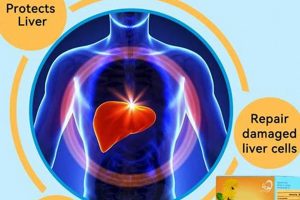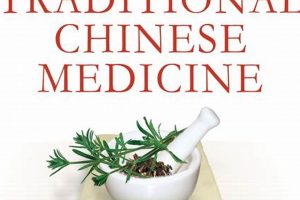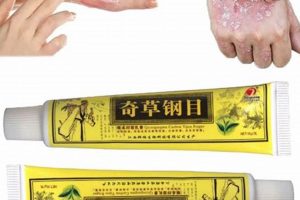Topical solutions derived from traditional Chinese medicine, prepared by macerating herbs in alcohol or other solvents, have been utilized for centuries. These preparations are applied externally to alleviate pain, reduce inflammation, and promote healing in musculoskeletal conditions. Examples include formulations designed for sprains, strains, arthritis, and muscle soreness.
The value of these preparations lies in their potential to deliver targeted therapeutic effects directly to the affected area. Practitioners believe they can enhance circulation, break up stagnation, and facilitate the body’s natural healing processes. Historically, they have been integral to martial arts training and traditional medical practices, passed down through generations of practitioners and healers.
The following sections will delve into the specific herbal ingredients commonly found in these formulations, explore the mechanisms by which they are believed to exert their effects, and examine the current research landscape regarding their efficacy and safety. Furthermore, manufacturing standards and application techniques will be addressed.
Guidance on Topical Herbal Formulations
The following recommendations are intended to provide information on the safe and effective application of these preparations. Adherence to these guidelines can maximize potential benefits while minimizing risks.
Tip 1: Ingredient Awareness: Prior to application, meticulously review the ingredient list. Individuals with known allergies to any component should avoid use. Common allergens include certain resins, essential oils, and specific herbs.
Tip 2: Skin Sensitivity Assessment: Perform a patch test before widespread application. Apply a small amount to an inconspicuous area, such as the inner arm, and monitor for adverse reactions like redness, itching, or blistering for 24-48 hours.
Tip 3: Proper Application Technique: Apply a thin layer to the affected area. Avoid excessive amounts, which may increase the risk of skin irritation. Gently massage into the skin until absorbed.
Tip 4: Application Frequency: Adhere to the recommended application frequency specified on the product label or as advised by a qualified practitioner. Overuse can lead to adverse effects.
Tip 5: Avoid Open Wounds: Do not apply to broken skin, open wounds, or areas of active infection. This can increase the risk of systemic absorption and potential complications.
Tip 6: Storage Considerations: Store in a cool, dark place away from direct sunlight and heat. Exposure to extreme temperatures can degrade the active ingredients and reduce efficacy.
Tip 7: Consultation with Practitioners: Seek guidance from a licensed healthcare professional or a practitioner of traditional Chinese medicine before initiating use, especially if pregnant, breastfeeding, or taking other medications.
These preparations offer a potentially valuable adjunct to pain management and musculoskeletal care when used responsibly. Diligence in following application guidelines and ingredient awareness is paramount.
The ensuing sections will further examine the research surrounding these formulations and address specific conditions for which they may be considered.
1. Analgesic Properties
The analgesic properties inherent in topical herbal preparations are fundamental to their therapeutic application. These properties address pain directly, representing a primary mechanism through which these solutions provide relief. Certain ingredients, such as menthol, camphor, and methyl salicylate, are known for their counterirritant effects. These compounds stimulate sensory nerve endings in the skin, creating sensations of warmth or coolness that can temporarily override the perception of pain. This mechanism, often described as “gate control theory,” effectively distracts the nervous system, mitigating pain signals traveling to the brain.
The inclusion of specific herbs also contributes to the overall analgesic effect. For instance, formulations containing extracts from plants known for anti-inflammatory compounds, like willow bark (a source of salicylic acid), can address pain stemming from inflammation. The combination of counterirritants and anti-inflammatory herbal components creates a synergistic effect, providing multifaceted pain relief. The practical implication is a reduced reliance on systemic analgesics, potentially minimizing adverse side effects associated with oral medications. Many athletes and individuals experiencing musculoskeletal pain use these as an alternative treatment. This approach highlights the importance of understanding the specific ingredients and their respective roles in achieving optimal analgesic outcomes.
In summary, the analgesic properties of topically applied herbal solutions are crucial to their effectiveness. The integration of counterirritants and anti-inflammatory herbs enables targeted pain relief by employing various physiological mechanisms. Understanding this interplay allows practitioners and individuals to select and utilize appropriate formulations for specific pain conditions, fostering a more holistic approach to pain management. The development of effective treatments of this type has been the focus of modern research as well as historical and traditional medicines.
2. Herbal Composition
The herbal composition is the foundational element dictating the therapeutic properties and intended applications of topically applied solutions. The specific blend of herbs determines the solution’s efficacy in addressing various conditions.
- Qi-Moving Herbs
Certain herbs, such as frankincense (, R Xing) and myrrh (, M Yo), are traditionally used to promote the circulation of Qi and blood. They are included to alleviate stagnation, reduce swelling, and ease pain associated with injuries. Their presence facilitates the delivery of other therapeutic compounds to the affected area.
- Blood-Invigorating Herbs
Herbs like safflower (, Hng Hu) and angelica sinensis (, Dng Gu) are believed to invigorate blood circulation, dispersing blood stasis and promoting tissue regeneration. They are employed in formulations designed to address bruising, hematomas, and chronic pain conditions stemming from poor circulation.
- Heat-Clearing Herbs
When inflammation is a primary concern, herbs with cooling properties, such as gardenia (, Zh Zi) and scutellaria baicalensis (, Hung Qn), are incorporated. These herbs help to reduce inflammation, redness, and heat, thus alleviating pain and promoting healing in acute injuries.
- Damp-Dispelling Herbs
In cases where dampness is considered a contributing factor, such as in arthritis or joint pain exacerbated by weather conditions, herbs like atractylodes lancea (, Cng Zh) and coix seed (, Y Y Rn) are utilized. These herbs aim to dispel dampness, reducing swelling and improving joint mobility.
The careful selection and combination of these herbal categories are crucial for formulating solutions tailored to specific conditions. The precise ratios and preparation methods further influence the potency and bioavailability of the active compounds. The herbal composition, therefore, is not merely a list of ingredients but a complex interplay of therapeutic actions designed to promote healing and alleviate symptoms.
3. Topical Application
The method of topical application is integral to the efficacy of herbal solutions. This mode of delivery allows for targeted treatment, concentrating the therapeutic effects at the site of injury or discomfort while minimizing systemic exposure.
- Enhanced Permeability
The effectiveness of topical application hinges on the ability of the active compounds to penetrate the skin barrier. Preparations often include solvents, such as alcohol, that enhance permeability, facilitating the absorption of herbal constituents. This targeted delivery ensures a higher concentration of active compounds at the affected area, promoting faster relief and healing.
- Localized Action
Topical application enables direct targeting of musculoskeletal issues, such as sprains, strains, and arthritis. By applying the solution directly to the affected area, the herbal compounds can exert their anti-inflammatory, analgesic, and circulation-enhancing effects precisely where they are needed. This localized action reduces the risk of systemic side effects and optimizes therapeutic outcomes.
- Dosage Control
Topical application allows for precise control over the dosage of active compounds. The amount applied can be adjusted based on the severity of the condition and the individual’s response to the treatment. This flexibility enables personalized treatment plans, ensuring that patients receive the optimal dose for their specific needs.
- Minimized Systemic Effects
Compared to oral medications, topical application generally results in lower systemic absorption of active compounds. This reduces the risk of systemic side effects, making it a safer option for individuals who are sensitive to medications or have underlying health conditions. The reduced systemic exposure allows for more frequent and prolonged use without significant concerns about adverse effects.
The choice of topical application as the primary delivery method for herbal solutions underscores the importance of targeted, localized treatment. By optimizing permeability, controlling dosage, and minimizing systemic effects, this approach maximizes the therapeutic benefits while minimizing potential risks. This is the reason this has been effective for centuries.
4. Circulation Enhancement
The enhancement of circulation constitutes a core therapeutic principle underlying the application of certain topical herbal preparations. Traditional Chinese medicine posits that pain and dysfunction often arise from stagnation of blood and Qi (vital energy). Topical herbal solutions are formulated to address this stagnation by promoting vasodilation, improving blood flow to the affected area, and facilitating the removal of inflammatory mediators. This improved circulation aids in delivering oxygen and nutrients to damaged tissues, accelerating the healing process. For example, formulations containing cinnamon bark ( Rou Gui) are believed to possess warming properties that dilate blood vessels, thereby increasing local blood flow to areas affected by cold or injury.
The inclusion of specific herbs with circulatory-enhancing properties is crucial for the effectiveness of these topical treatments. Ingredients such as safflower ( Hong Hua) and ginger ( Sheng Jiang) are commonly incorporated to invigorate blood circulation and disperse blood stasis. The improved blood flow helps to alleviate pain, reduce swelling, and promote tissue regeneration. This is practically significant in conditions like sprains, strains, and contusions, where impaired circulation can impede recovery. Furthermore, this enhanced circulation also supports the absorption and distribution of other therapeutic herbal constituents within the formulation, maximizing their overall impact. This leads to greater relief and healing to specific affected areas.
In summary, the intentional design to enhance circulation is not merely an ancillary benefit but a fundamental mechanism through which these preparations exert their therapeutic effects. By addressing circulatory stagnation, these formulations aim to restore balance, promote healing, and alleviate pain in a localized and targeted manner. While anecdotal evidence and traditional use support these claims, further rigorous scientific investigation is warranted to fully elucidate the specific physiological mechanisms involved. Additionally, one must be careful in identifying that this is but one aspect of “chinese herbal liniments”, and that there can be several mechanisms at play.
5. Inflammation Reduction
Inflammation reduction constitutes a critical therapeutic objective for many preparations. The body’s inflammatory response, while essential for healing, can become excessive or chronic, leading to pain, tissue damage, and impaired function. Certain topical solutions are formulated with herbs known for their anti-inflammatory properties, targeting the underlying causes of discomfort and promoting tissue repair. The inclusion of such herbs aims to modulate the inflammatory cascade, reducing the production of pro-inflammatory mediators and promoting the resolution of inflammation. This process is paramount in conditions such as arthritis, tendonitis, and acute injuries, where inflammation plays a significant role in the pathogenesis of pain and dysfunction.
The effectiveness of these preparations in reducing inflammation stems from the synergistic actions of various herbal constituents. For instance, formulations containing licorice root (Gan Cao ) or turmeric (Jiang Huang*) possess compounds that inhibit the activity of inflammatory enzymes, such as cyclooxygenase (COX) and lipoxygenase (LOX). These enzymes are key players in the synthesis of pro-inflammatory molecules, and their inhibition helps to dampen the inflammatory response. In practical applications, individuals with osteoarthritis may experience reduced joint pain and stiffness due to the anti-inflammatory effects of these topical solutions. Similarly, athletes recovering from sports-related injuries may find relief from muscle soreness and swelling through the application of preparations containing herbs with cooling and anti-inflammatory properties. This is important for both performance athletes as well as more casual users. Moreover, this is an increasingly important sector of both athletics and the medical community.
In conclusion, inflammation reduction is a fundamental aspect of the therapeutic rationale and design of many preparations. By incorporating herbs with potent anti-inflammatory properties, these solutions aim to address the root causes of pain and dysfunction associated with inflammation. While traditional use and anecdotal evidence support the efficacy of these preparations, further scientific research is necessary to fully elucidate the specific mechanisms of action and validate their clinical effectiveness. Understanding the interplay between inflammation and herbal constituents is crucial for optimizing the use of these topical solutions in managing inflammatory conditions. Also it is important to note that this is just one use, and that the topic is complex.
6. Traditional Usage
Traditional usage forms the bedrock upon which the application and understanding of preparations rest. These preparations are not simply concoctions of herbs; they are the product of centuries of empirical observation, refinement, and transmission of knowledge within traditional Chinese medicine (TCM). Their traditional applications provide critical insights into their intended purposes, appropriate uses, and expected outcomes.
- Martial Arts and Trauma
Traditionally, such preparations were integral to martial arts practices. They were used to treat injuries sustained during training and combat, such as bruises, sprains, and fractures. The herbal formulations were designed to reduce pain, swelling, and inflammation, facilitating faster healing and return to training. This legacy underscores the value of these preparations in managing acute musculoskeletal trauma.
- Musculoskeletal Disorders
These preparations have a long history of use in managing chronic musculoskeletal disorders, such as arthritis and back pain. Herbal combinations were formulated to address the underlying imbalances contributing to these conditions, such as stagnation of Qi and blood. Regular application was believed to alleviate pain, improve joint mobility, and enhance overall quality of life. They were often the treatment of choice, especially in remote areas.
- Wind-Damp Conditions
Traditional texts describe the use of these solutions for conditions attributed to the invasion of “wind-damp,” characterized by joint pain, stiffness, and swelling that worsen in cold, damp weather. Specific herbal combinations were employed to dispel these pathogenic factors, alleviate symptoms, and restore balance to the body. This remains a relevant application in regions with humid climates.
- Skin Ailments
Certain herbal preparations were traditionally used to address skin ailments, such as eczema and psoriasis. While the formulations differed from those used for musculoskeletal conditions, they shared the common goal of reducing inflammation, promoting healing, and restoring skin integrity. This highlights the versatility of traditional herbal medicine in addressing a range of health concerns.
The traditional usage of preparations offers invaluable context for their modern application. Understanding their historical purposes, intended outcomes, and traditional diagnostic frameworks can inform contemporary practice and enhance the effectiveness of these therapeutic modalities. Although the modern user may have a very different background than the traditional herbalists, these preparations have lasting value.
7. Preparation Methods
The efficacy of topical herbal preparations is inextricably linked to the methods employed in their creation. The selection of appropriate preparation techniques directly influences the extraction of active compounds from raw herbs, their subsequent bioavailability, and ultimately, the therapeutic outcome. Improper preparation can render potentially potent ingredients ineffective or even harmful. The methods used determine the concentration of active constituents, the stability of the final product, and the ease with which the formulation can be applied and absorbed. For example, a preparation utilizing insufficient maceration time may fail to adequately extract key anti-inflammatory compounds, reducing its effectiveness in treating conditions like arthritis. Conversely, overheating certain herbs during decoction can degrade delicate volatile oils, diminishing their analgesic properties. These are important factors in determining the final value of the resulting product.
Varied techniques are utilized to create these preparations, each suited to specific herbal combinations and desired therapeutic effects. Maceration, involving the soaking of herbs in a solvent such as alcohol or vinegar, is commonly employed to extract resins, alkaloids, and other lipophilic compounds. Decoction, the boiling of herbs in water, is used to obtain water-soluble components like polysaccharides and glycosides. Distillation can isolate volatile oils, while enfleurage, a traditional method involving the absorption of aromatic compounds into fats, yields highly fragrant and therapeutically valuable extracts. A real-world example includes the preparation of formulas containing aconite ( Wu Tou), a potent herb requiring careful processing to neutralize its toxicity. Traditional methods involve prolonged boiling and the addition of specific auxiliary herbs to reduce its adverse effects while preserving its analgesic properties. Failure to adhere to these protocols can result in serious adverse reactions. Therefore it is very important to note that this requires great skill.
In conclusion, the significance of preparation methods in determining the quality and effectiveness of these preparations cannot be overstated. Proper techniques ensure the optimal extraction, preservation, and delivery of active herbal constituents, maximizing their therapeutic potential while minimizing the risk of adverse effects. Contemporary manufacturing processes must adhere to stringent quality control standards to replicate the traditional art of herbal preparation while ensuring product safety and consistency. This understanding bridges traditional knowledge with modern scientific principles, safeguarding the integrity and efficacy of these time-honored remedies. Modern improvements in safety have been important, such as standardization for ingredients, and improvements in the preparation methods, and in ingredient tracing.
Frequently Asked Questions
This section addresses common inquiries regarding topically applied herbal preparations, aiming to provide clarity and evidence-based information.
Question 1: Are all topical herbal preparations safe for everyone?
No, individual sensitivities and allergies to specific herbal components exist. A patch test is recommended prior to widespread application. Pregnant or breastfeeding individuals, and those with pre-existing medical conditions, should consult a qualified healthcare professional or TCM practitioner before use.
Question 2: How long does it typically take to experience noticeable results?
The timeframe for experiencing benefits varies depending on the individual, the severity of the condition, and the specific formulation. Some individuals may experience immediate pain relief due to counterirritant effects, while others may require several days or weeks of consistent application to observe significant improvements in chronic conditions.
Question 3: Is there scientific evidence to support the efficacy of topical herbal preparations?
While traditional use and anecdotal evidence abound, scientific research is ongoing. Some studies suggest potential benefits for pain management and inflammation reduction, but further rigorous clinical trials are needed to validate these findings and establish definitive efficacy for specific conditions. Many modern studies are underway.
Question 4: Can topical herbal preparations interact with other medications?
While systemic absorption is generally limited, potential interactions with other medications, particularly those affecting blood clotting or skin sensitivity, cannot be entirely ruled out. Consultation with a healthcare professional is advisable, especially when using other topical or systemic medications concurrently.
Question 5: How should these solutions be stored to maintain their potency?
Proper storage is crucial. Products should be stored in a cool, dark place away from direct sunlight and heat. Exposure to extreme temperatures can degrade the active ingredients and reduce their effectiveness. The lid should be tightly sealed.
Question 6: What are the potential side effects associated with topical application?
Common side effects include skin irritation, redness, itching, and allergic reactions. Discontinue use immediately if any adverse reactions occur. In rare cases, more severe allergic reactions may necessitate medical attention. It is important to note all ingredients and compounds before use.
These FAQs provide a general overview. Responsible use requires informed decision-making and, when appropriate, professional guidance.
The subsequent section will discuss regulatory aspects and quality control measures related to topical preparations.
Conclusion
This examination of chinese herbal liniments has underscored their complex nature, encompassing a rich history, intricate preparation methods, and diverse therapeutic applications. From their roots in traditional Chinese medicine to their potential role in contemporary pain management, these formulations represent a confluence of ancient wisdom and evolving scientific understanding. The responsible utilization of such preparations necessitates a comprehensive awareness of their composition, application techniques, and potential risks.
Continued rigorous research is imperative to fully elucidate the mechanisms of action and validate the clinical efficacy of chinese herbal liniments. Furthermore, adherence to stringent quality control standards is paramount to ensure product safety and consistency. As the body of knowledge surrounding these formulations expands, informed practitioners and consumers can make judicious decisions regarding their integration into holistic healthcare approaches. This should be done cautiously, and always with a qualified medical professional.







